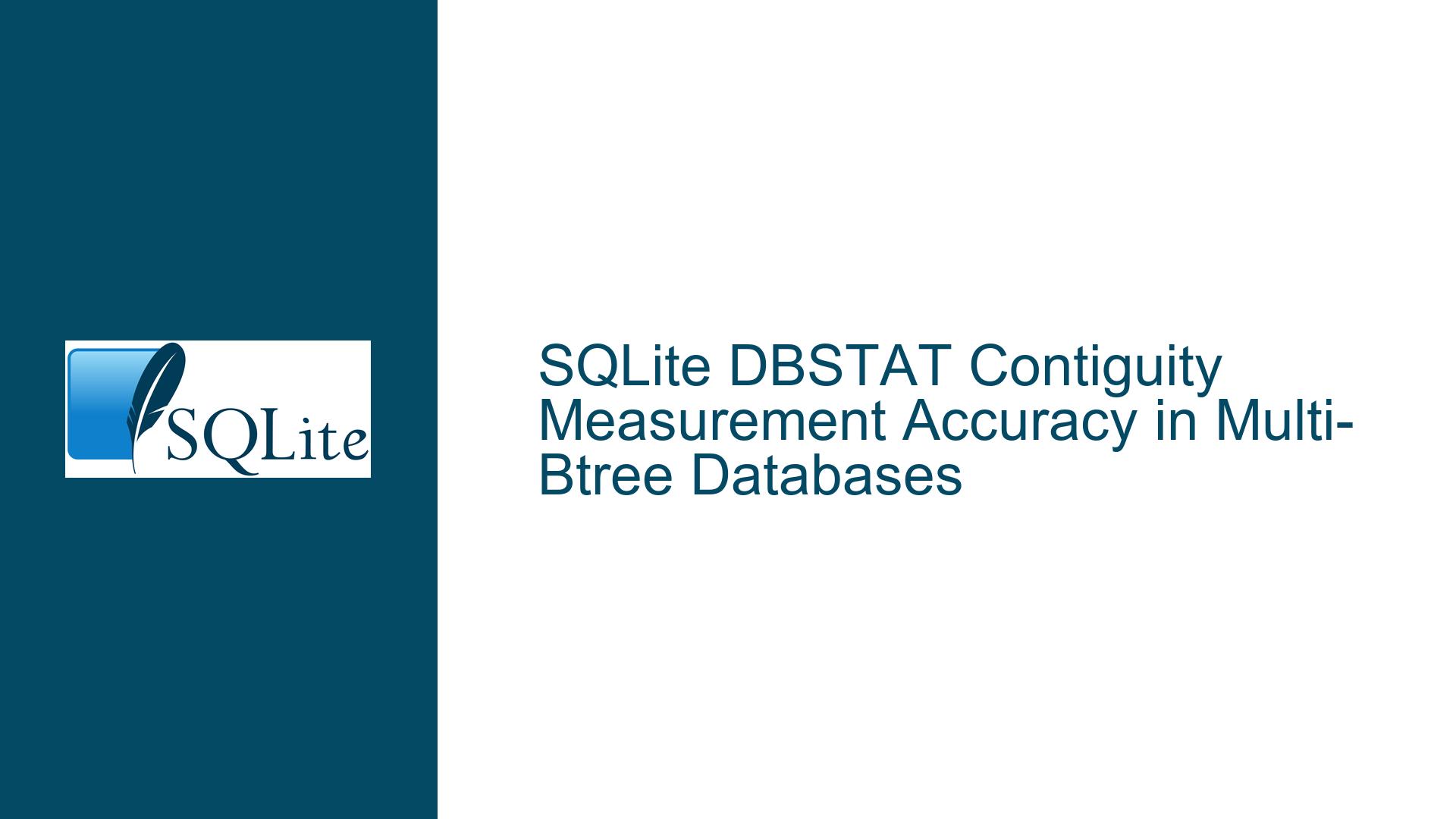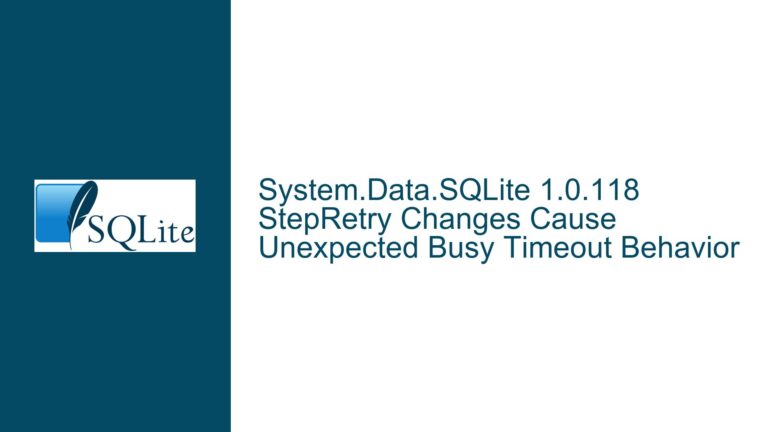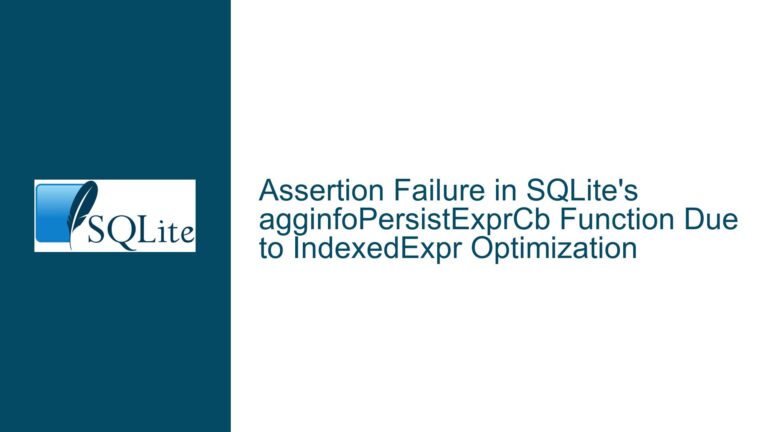SQLite DBSTAT Contiguity Measurement Accuracy in Multi-Btree Databases
Understanding Database File Contiguity Analysis in SQLite’s DBSTAT Virtual Table
The measurement of database file contiguity serves as a critical performance indicator in SQLite databases, directly impacting read efficiency and overall query performance. The DBSTAT virtual table provides essential insights into the physical organization of database pages, enabling developers to assess and optimize storage characteristics. The contiguity measurement specifically examines the sequential arrangement of database pages on disk, with higher contiguity generally correlating to better read performance due to reduced disk seek operations.
When dealing with SQLite databases containing multiple B-tree structures, the accuracy of contiguity measurements becomes particularly significant. Each B-tree represents a distinct table or index within the database, maintaining its own hierarchical structure of pages. The physical arrangement of these pages across the database file directly influences the database’s performance characteristics, especially during sequential read operations.
The conventional approach to measuring database contiguity involves analyzing the sequential nature of page numbers within the database file. A perfectly contiguous database would have all pages arranged in sequential order, minimizing the need for disk head movement during read operations. However, the complexity increases substantially when dealing with multiple B-trees, as each B-tree maintains its own logical sequence of pages that may be interspersed throughout the physical database file.
Root Cause Analysis: Path Ordering in Multi-Btree Environments
The core issue stems from the methodology used to order database pages when calculating contiguity. The original measurement query focuses solely on the path column from the DBSTAT virtual table, without considering the hierarchical relationship between different B-trees in the database. This approach leads to several technical complications:
Page Ordering Misconception
The path column in DBSTAT represents the traversal path within a specific B-tree structure. When multiple B-trees exist in the database, their paths may have similar or identical values, despite belonging to entirely different logical structures. Ordering solely by path creates an artificial interleaving of pages from different B-trees, leading to misleading contiguity calculations.
B-tree Independence
Each B-tree in an SQLite database maintains its own independent page structure. The physical contiguity of pages within one B-tree has no logical relationship to the contiguity of pages in another B-tree. By treating all paths equally without considering their parent B-trees, the measurement fails to accurately represent the true physical organization of the database.
Vacuum Impact Assessment
The current measurement approach may indicate poor contiguity even immediately following a VACUUM operation, which should theoretically optimize page arrangement. This contradiction occurs because the measurement algorithm incorrectly interprets the natural separation between different B-trees as fragmentation, even when each B-tree’s pages are perfectly contiguous within their own logical space.
Implementing Accurate Contiguity Analysis and Optimization Strategies
To achieve accurate contiguity measurements and optimize database performance, several technical approaches and solutions can be implemented:
Enhanced Measurement Query
The following modified query provides a more accurate assessment of database contiguity by considering both the B-tree structure and path information:
CREATE TEMP TABLE s(rowid INTEGER PRIMARY KEY, pageno INT);
INSERT INTO s(pageno)
SELECT pageno
FROM dbstat
ORDER BY name, path;
SELECT sum(s1.pageno + 1 == s2.pageno) * 1.0 / count(*)
FROM s AS s1, s AS s2
WHERE s1.rowid + 1 = s2.rowid;
DROP TABLE s;
This enhanced version orders pages by both the B-tree name (name) and path, ensuring that pages belonging to the same B-tree are evaluated together. The modification produces significantly more accurate contiguity measurements, particularly for databases with multiple large B-trees.
Per-Btree Analysis Methodology
For comprehensive database optimization, implementing a B-tree-specific analysis approach provides more granular insights:
WITH btree_contiguity AS (
SELECT name,
sum(s1.pageno + 1 == s2.pageno) * 1.0 / count(*) as contiguity
FROM (
SELECT name, pageno,
row_number() OVER (PARTITION BY name ORDER BY path) as rn
FROM dbstat
) s1
JOIN (
SELECT name, pageno,
row_number() OVER (PARTITION BY name ORDER BY path) as rn
FROM dbstat
) s2 ON s1.name = s2.name AND s1.rn + 1 = s2.rn
GROUP BY name
)
SELECT name,
round(contiguity * 100, 2) as contiguity_percentage
FROM btree_contiguity
ORDER BY contiguity_percentage DESC;
This advanced query provides contiguity measurements for each B-tree independently, offering a more nuanced view of database organization.
Optimization Techniques
To maintain optimal contiguity across multiple B-trees:
PRAGMA auto_vacuum = FULL;
PRAGMA page_size = 4096;
VACUUM;
These PRAGMA settings ensure efficient space reuse and optimal page size configuration. The VACUUM command reorganizes the database file, but its effectiveness should now be measured using the enhanced contiguity queries.
Monitoring and Maintenance Procedures
Regular monitoring of B-tree-specific contiguity helps identify fragmentation issues early:
CREATE TRIGGER monitor_contiguity
AFTER INSERT ON schema
BEGIN
-- Insert contiguity measurements into monitoring table
INSERT INTO contiguity_history (
timestamp,
btree_name,
contiguity_score
)
SELECT datetime('now'),
name,
(SELECT sum(s1.pageno + 1 == s2.pageno) * 1.0 / count(*)
FROM (
SELECT pageno, row_number() OVER (ORDER BY path) as rn
FROM dbstat
WHERE name = NEW.name
) s1
JOIN (
SELECT pageno, row_number() OVER (ORDER BY path) as rn
FROM dbstat
WHERE name = NEW.name
) s2 ON s1.rn + 1 = s2.rn)
FROM dbstat
WHERE name = NEW.name
GROUP BY name;
END;
This trigger-based monitoring system automatically tracks contiguity changes over time, enabling proactive maintenance scheduling and performance optimization.
The implementation of these solutions ensures accurate contiguity measurements while maintaining optimal database performance. Regular monitoring and maintenance using these enhanced tools help maintain high contiguity levels across all B-trees in the database, ultimately contributing to better query performance and reduced disk I/O operations.






